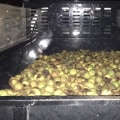Walnut trees produce a walnut harvest every year from 7 to 15 years old, depending on the species. The best nut yields will not occur until the tree is over 20 years old. Walnut trees are capable of producing nuts every year, but you may experience patterns of high and low yields from year to year. Like many trees that produce nuts and fruits, walnut trees are prone to a reproductive pattern known as alternate bearing.
This is characterized by alternating years of high crop yields followed by light or no nut production. So, while you're likely to see some nuts every year on your walnut tree, expect the amount of harvest to vary. The average walnut tree starts producing nuts at the age of 8 to 10 years. However, there are cases where walnut trees begin to produce between 15 and 22 pounds.
Most commercial walnut orchards reach their peak production level at an age of 30 years or older. Healthy, mature walnut trees produce 66 to 350 pounds. The tree has an inherent tendency to alternate production and generally produces good production every two years. A product of these trees is nut crops every two years.
In the 1930s, during the Depression, my mother baked black walnut cakes to sell them and earn a few extra dollars. These were difficult times and every dollar earned helped. Sometimes trees that produce nuts, such as walnut, walnut, and walnut, drop their fruits before full maturity. Sometimes, it can be a natural shedding of a portion of the nut crop.
Other causes may be more problematic, such as adverse weather conditions, poor tree health, inadequate pollination, insects and diseases. When it comes to making a profit from selling English and black walnut trees as wood, there aren't many general rules or average prices. While a mature walnut tree is likely to produce some nuts each year, the tree will alternate between a bountiful harvest one year and a light harvest the next. I take the nuts from each fall to the National Forest and find an unoccupied gophone hole to drop one and step on the hole to make the earth accumulate the nut for the winter.
The settlers ate the nutritious nuts uncontrollably, added them to soups and stews, and ground them to bake; the hard shells provided a perfect package for storing walnuts for the winter. Tomatoes, potatoes, apples, pears, berries, and some landscape plants, such as rhododendrons, azaleas, and lilacs, can die or stunt if grown near the roots of the black walnut tree or within the tree's drip line (i. Some walnut cultivars appear to be more susceptible to alternative production than others, and older trees are more prone to uneven production than younger ones. Other insects, such as black aphids, pecan caterpillar, shellworms, stinking bugs, and pecan weevils can cause early nut fall.
A prolonged drought during nut growth can also cause nuts to fall, especially if the plant is in sandy soil that dries quickly. In most countries, farmers harvest by hand, shaking branches so that nuts can fall into special harvesting nets that have been placed in the ground. Easy-to-work, fine-grained black walnut wood has long been prized by furniture makers and cabinet makers for its attractive color and exceptional durability. Black walnut is highly vulnerable to anthracnose, and the disease is a major concern in commercial gardens.
In general, the diameter of the tree is measured at a height of 4.5 feet (1.37 meters) from the ground, and this figure is important. Providing the tree with exceptional cultural care will help the walnut tree fight any pests or diseases and therefore prevent sporadic losses. Then, a special machine picks up the nuts from the ground and performs a necessary first sorting step (broken stems and leaves are removed). .


